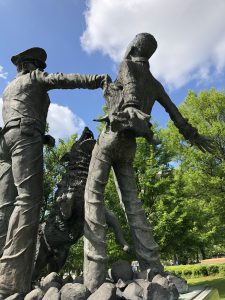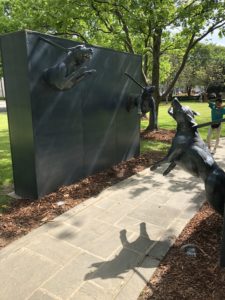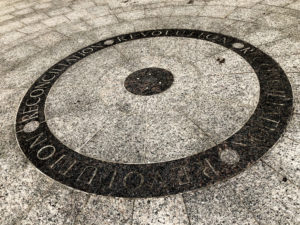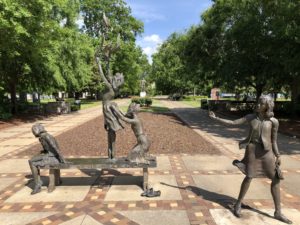“To me, this memorial doesn’t call forth anger, but pain, anguish, and most importantly, critical thought- if this is our truth, we must face it; and then, what must my action be?”
A reflection by YLI CEO, Jon Marker, on the Equal Justice Initiative Museum & Memorial Opening in Montgomery, Alabama.
Walking through Kelly Ingram Park, in Birmingham, Alabama I came across a memorial to the courage of the young people who served in the Children’s Crusade. I was struck by the words in stone on each entrance to the memorial: “A place of Revolution and Reconciliation.” This is not meant to be a space of guilt or shame. This is a place to take an honest accounting of ourselves and our history, to learn, and to evolve.
 As a white man traveling to Alabama for the first time, I was immediately struck, but not surprised, by the underinvestment in the spaces key to the narrative of the mid-century Civil Rights Movement. At Birmingham’s 16th St Baptist Church, where Denise McNair, Carole Robertson, Addie Mae Collins and Cynthia Wesley were murdered (the same age as the young people in Youth Leadership Institute’s programs), and in Kelly Ingram Park, there were statues in various stages of disrepair, fountains absent water.
As a white man traveling to Alabama for the first time, I was immediately struck, but not surprised, by the underinvestment in the spaces key to the narrative of the mid-century Civil Rights Movement. At Birmingham’s 16th St Baptist Church, where Denise McNair, Carole Robertson, Addie Mae Collins and Cynthia Wesley were murdered (the same age as the young people in Youth Leadership Institute’s programs), and in Kelly Ingram Park, there were statues in various stages of disrepair, fountains absent water.
One hundred miles away, at the foot of the Edmund Pettus Bridge on Water Street, there is a historical landmark that recognizes the recent blockbuster film Selma with a light mention of the actual story of bravery and sacrifice. It is as if the local tourism commission, who erected the sign, believes that our country should celebrate the film as much as the people who marched 50 miles, through beatings and death threats, to ensure their fundamental rights were upheld. At the other foot of the bridge, made iconic by the violence Congressman John Lewis and others endured when they were confronted by the brutality of the state; the sidewalk quickly disappears and you are left standing on a thin slice of dirt as traffic speeds by. Forty yards further, there is a mural and limited remembrance of the key figures of the March, underwhelming for a place and moment in time that changed the course of our country’s history.
 The intersection between the historical significance of these places, and the state of disrepair is powerful. The narrative birthed from these spaces is revered in our national dialogue and fundamentally shifted the course of our history, yet standing in the dried, overgrown grass and broken water fountains, it also feels ignored. “A place of Revolution and Reconciliation.” Revolution, certainly. Reconciliation? I’m not so sure.
The intersection between the historical significance of these places, and the state of disrepair is powerful. The narrative birthed from these spaces is revered in our national dialogue and fundamentally shifted the course of our history, yet standing in the dried, overgrown grass and broken water fountains, it also feels ignored. “A place of Revolution and Reconciliation.” Revolution, certainly. Reconciliation? I’m not so sure.
Approaching the National Memorial for Peace and Justice is different. This memorial serves as a sacred place to honor and share the story of the more than 4,000 people who were lynched in a wave of racial terror. To see the names of those who were lynched, who were murdered, who were sacrificed at the hands of terrorism with endorsement from the state, is to be forced to reconcile the dissonance in the national narrative that ignores parts of our country’s history while elevating others. To me, this memorial doesn’t call forth anger, but pain, anguish, and most importantly, critical thought- if this is our truth, we must face it; and then, what must my action be? If we are to acknowledge, to memorialize, to tell the truth and begin to heal, how can this place help us do this work of reconciliation everywhere?
This new Memorial and the nearby Legacy Museum are projects of Bryan Stevenson and the Equal Justice Initiative. Together these people, organizations, and places make the case that slavery never ended, rather, it evolved into the system of mass incarceration we see today. This thesis, this realization, is powerful. For if we understand and believe, then we are not only viewing history that has past- we are holding in ourselves a burning question: what will we do to face slavery on our shores, today? There is a weight to that question, one that is not easily answered. The weight quickly becomes unbearable when you think about all of the external forces at play, to overcome. But as he does so well, Stevenson, his team, and the experience curated in these spaces redirect the question- what if this work is not about fixing other people, but realizing that we are all broken, that we all need healing, and that we should strive every day to heal ourselves and those around us? This new Memorial welcomes in everyone brave enough to face truth. It challenges us to let down our guard and grow, to reconcile with ourselves the truths of our own history, and to commit to the evolution of self, of community.
By asking more of us as a country, in particular those of us like myself who have upheld and benefited from white supremacy explicitly and by omission, this memorial is helping us to BE more, a gift that we should bring back to our communities. Will we rise to the occasion? Can we make an honest accounting of our past? Perhaps, if we live up to this moment, acknowledging the sins of those who relied on the social construct of race to abuse, enslave, terrorize, and murder other humans, we will be able to reconcile and make more sense of the story of our nation. In so doing, we will make way for an (r)evolution of our society that dismantles the status quo of the present.
This article was published in Medium — take a read and show your support by clapping it on!


